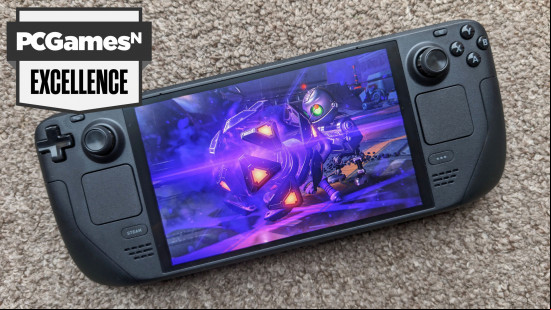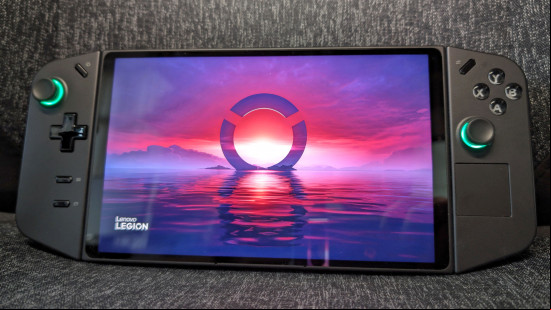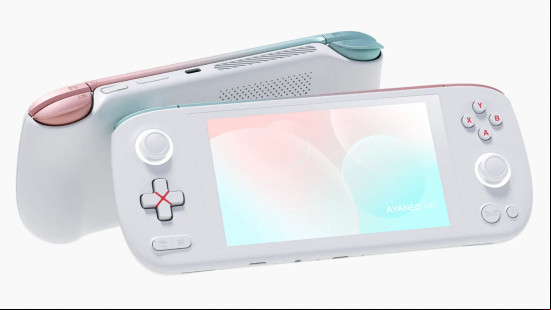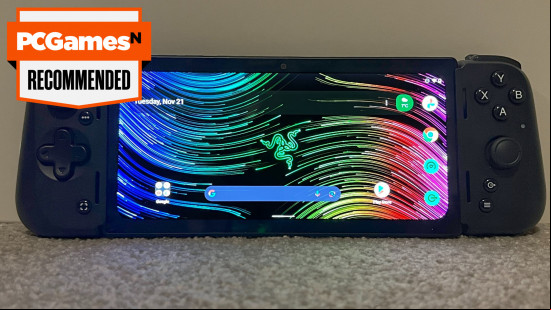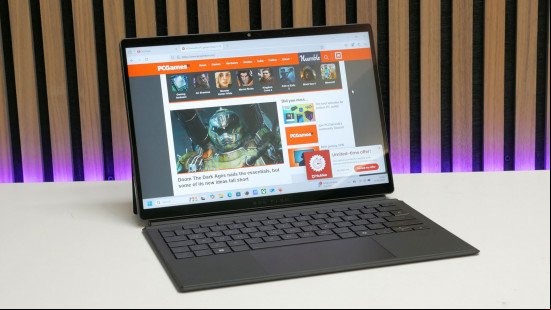What is the best handheld gaming PC? This year is set to see some big new entrants in the gaming handheld space, including the Ayaneo 3 that we just reviewed. After hundreds of hours of testing, our top handheld picks remain the same as they have for a while, and you can find those choices below.
The best overall remains the Also Tested section, which includes other handhelds we've reviewed that didn't quite make this list.
Why you can trust our advice ✔ At PCGamesN, our experts spend hours testing hardware and reviewing games and VPNs. We share honest, unbiased opinions to help you buy the best. Find out how we test.
Best handheld gaming PCs:
Steam Deck OLED
Best handheld gaming PC overall
Steam Deck OLED specifications:
| APU |
AMD Zen 2 |
| Cores |
4 |
| Threads |
8 |
| Graphics |
AMD RDNA 2 (8 CUs) |
| RAM |
16GB LPDDR5 (6,400MT/s) |
| Display |
7.4-inch OLED (1280 x 800 / 90Hz / HDR) |
| Storage |
512GB NVMe SSD, 1TB NVMe SSD |
| Weight |
640g |
| OS |
SteamOS |
Pros
- OLED screen is stunning
- Better battery life
- Runs quietly and stays cool
Cons
- APU performance is unchanged
- Not available with less than 512GB storage
- SteamOS still has annoying quirks
Valve has realized the full potential of its handheld with the Steam Deck OLED. The screen is bigger, brighter, and better than the original Deck in our number two spot, but the refresh is far more than meets the eye.
You get improvements to battery life for longer gaming sessions, a weight reduction for greater comfort, plus faster Wi-Fi for quicker s. The Steam Deck OLED is the best handheld PC gaming there is, with a few downsides. The APU inside the OLED is almost identical to the original Deck, save for efficiency, and that places this handheld significantly behind the curve in of power. Simply put, some AAA game releases will be out of reach to you on this device.
If you're looking for a well-priced handheld with a stunning display and access to your Steam library on the go, though, the Steam Deck OLED is the top choice.
Read our Steam Deck OLED review.
Steam Deck
Best value handheld gaming PC
Steam Deck specifications:
| APU |
AMD Van Gogh |
| Cores |
4 |
| Threads |
8 |
| Graphics |
8 RDNA 2 CUs |
| RAM |
16GB LPDDR5 5500 MT/s quad channel |
| Display |
7-inch IPS 800p/40-60Hz (fixed) |
| Storage |
64GB eMMC, 256GB or 512GB PCIe 3.0 SSD |
| Weight |
669g |
| OS |
SteamOS |
Pros
- Unmatched price-to-performance
- Huge aftermarket ecosystem
- SteamOS
Cons
- Lackluster screen
- Game compatibility
- Verification program isn't always correct
The Steam Deck wasn't the first handheld gaming PC, but it's certainly been the most successful. It gives you seamless integration with Steam and a console-like experience means it can be as plug-and-play as you like – with the benefit of having a completely -tweakable OS under the hood.
The lower-end 64GB model is now discontinued but you can still pick it up from retailers like Amazon, expand the storage, and pair it with the best Steam Deck accessories to bring it up to a usable capacity.
However, titles such as Remnant 2 all cause the Steam Deck to misstep. We're still some time away from all major AAA releases being unplayable on the Steam Deck – and there are thousands of other games still to play, but the clock is ticking and you may feel you get more value if you opt for a newer handheld.
The custom APU dubbed Van Gogh is still powerful enough for most games and if you mainly want to play retro games, 2D games, sidescrollers, or emulated titles then you will be more than happy with the performance. This is still a great-value handheld gaming PC.
Read our Steam Deck review.
Asus ROG Ally X
Best Windows handheld gaming PC
Asus ROG Ally X specifications:
| APU |
AMD Ryzen Z1 Extreme |
| Cores |
8 |
| Threads |
16 |
| Graphics |
12 RDNA 3 CUs |
| RAM |
24GB LPDDR5 7500 MT/s dual channel |
| Display |
7-inch IPS 1080p/120Hz VRR |
| Storage |
1TB PCIe 4.0 SSD 2280 M.2 / microSD |
| Weight |
678g |
| OS |
Windows 11 |
Pros
- 120Hz VRR display
- Same fast Ryzen Z1 chip as the Ally
- Big performance upgrades thanks to memory changes
Cons
- Windows still isn't handheld suitable
The Asus ROG Ally X is a big and welcome update to the original ROG Ally that transforms one of the earliest and most successful Windows handhelds into the clear top choice in its class.
With 8GB extra memory, and faster memory at that, the ROG Ally X can outperform just about any like-for-like handheld gaming PC available right now. Asus' Armoury Crate software overlay is much improved, and while not perfect, its interface is easier to understand and navigate, which is huge for those who don't want to engage with Windows 11.
The $799 price tag is hard to swallow, but fair. One expected advantage of Ally X's release is that the base Ally Z1 Extreme has also seen its price reduced quite drastically. However, if you're chasing the best performance in games without being limited to Steam, the Ally X has the Steam Deck and all other Ally handhelds beaten hands down.
Read our Asus ROG Ally X review.
Lenovo Legion Go
Most versatile handheld gaming PC
Lenovo Legion Go specifications:
| APU |
AMD Ryzen Z1 Extreme |
| Cores |
8 |
| Threads |
16 |
| Graphics |
AMD RDNA 3 (12 CUs) |
| RAM |
16GB LPDDR5X (7,500MHz) |
| Display |
8.8-inch IPS (2560 x 1600 /144Hz) |
| Storage |
Up to 1TB NVMe SSD |
| Weight |
854 / 640g (with controllers detached) |
| OS |
Windows 11 |
Pros
- Massive 8.8-inch screen
- Detachable controllers
- Great handheld performance
Cons
- 1600p is generally too high for GPU
- Heavy
- Fiddly software experience
With its 8.8-inch display, the Lenovo Legion Go is the handheld for you if you want a big-screen experience. While its size naturally helps with immersion, it's also responsive, sharp, and vivid. With a native resolution of 2560 x 1600 and a refresh rate of 144Hz, the IPS is about as good as it gets for an LCD handheld.
There's some powerful hardware too. The AMD Ryzen Z1 Extreme puts the Lenovo Legion Go well ahead of the Steam Deck for raw power and on par with most other high-end Windows handhelds, but it's also one of the most versatile thanks to the detachable controllers and kickstand, which give you a unique experience, especially in 'FPS Mode' where the controllers convert to mice, just like the new Nintendo Switch 2.
The Legion Go does have a few flaws. It's much heavier than its competitors, weighing in at 854g, which can make using it for long periods a bit tiring. You'll also need to tinker with settings and resolution fairly frequently, as the screen's native 1600p resolution is far too demanding for the Ryzen Z1 Extreme APU, and the software can be fiddly.
Read our Lenovo Legion Go review.
Ayaneo 3
Best screen quality
Ayaneo 3 specifications:
| APU |
AMD Ryzen AI 9 HX 370 |
| Graphics |
AMD Radeon 890M |
| RAM |
32GB LPDDR5X 7,500MT/s |
| Display |
7-inch OLED, 144Hz, 800nits, HDR true color, 150% sRGB, 110% DCI-P3 |
| Storage |
1TB M.2 2280 PCIe 4.0 SSD |
| Weight |
690g |
| OS |
Windows |
Pros
- Stunning OLED display and loud speakers
- Modular controls more than a gimmick
- Power and memory customization for improved performance
- Great gaming performance
Cons
- It's still a Windows handheld
- Pre-baked TDP profiles require tweaking
- No sleep function by default
- Poor battery life
When the Ayaneo 3 is on form, there is no handheld that comes close to it for stability and performance. Its powerful processor and deep customization options for tweaking its power settings means you can really hone in on getting the right balance for your needs.
What's more, its display is stunning. Its 1080p resolution combined with its compact 7-inch size makes it super sharp while the fact it uses OLED means you get incredible contrast and punchy colors. This handheld's speakers are surprisingly loud and clear too, while its overall ergonomics are great as well.
It has an extra trick up its sleeve too, in the shape of modular controllers. You can swap out the little thumbstick/buttons sections and change between an Xbox-style layout or symmetrical controls or change a thumbstick for all buttons. It sounds like a gimmick but it's actually really useful.
The only trouble is, all these high specs and extra features add costs, with this handheld demanding an eye-watering $2,000 for the top-spec models. More than its price, though, its the clunkiness of using Windows that holds this handheld back. For pure gaming ease of use, SteamOS handhelds are still so much better.
Read our Ayaneo 3 review.
Ayaneo Air
Best portable handheld gaming PC
Ayaneo Air specifications:
| APU |
AMD Ryzen 5 5560 |
| Cores |
6 |
| Threads |
12 |
| Graphics |
7 Vega 7 CUs |
| RAM |
16GB LPDDR4 4266 MT/s dual channel |
| Display |
5.5-inch OLED 1920×1080 |
| Storage |
512GB PCIe 4.0 SSD / microSD |
| Weight |
398g |
| OS |
Windows 11 |
Pros
- Extremely light and portable
- Gorgeous OLED
- Hall Effect joystick and triggers
Cons
- Underpowered
- No suspend feature
The Ayaneo Air stands out as among the smallest handheld gaming PCs around. With just a 5.5-inch OLED screen, it's a noticeable step down from the Steam Deck OLED and Asus ROG Ally X, let alone the much large Lenovo Legion Go.
This compactness makes it a great option for those seeking a handheld suitable for traveling light or using one of these devices on a regular commute where you're cramped for space and may have to stand. That's especially true as it's much lighter than others too, weighing in at just 398g compared to 640g for the Steam Deck OLED.
All that compactness comes with some obvious compromises, though. The AMD Ryzen 5 5560 chip in this handheld is considerably less powerful than most other handhelds. It can still play most games at low settings and 720p resolutions or lower but Steam Deck-level power was already right at the limit of what's useable for most games so the Ayaneo Air feels even more limited.
Battery life is limited too and the smaller screen means this feels less like a device you might want to use for other tasks such as watching video or browsing the web. Still, with a low asking price, it's potentially a great option for many buyers, if you can get hold of one, as stock seems to have mostly dried up since its launch in 2023.
GPD Win 4
Most gaming handheld PC
GPD Win 4 specifications:
| APU |
AMD Ryzen AI 9 HX 370 / AMD Ryzen 7 8840U |
| Cores |
8 |
| Threads |
16 |
| Graphics |
12 RNDA 2 CUs |
| RAM |
32GB LPDDR5 6400 MT/s dual channel |
| Display |
6.1-inch IPS 1920×1080 |
| Storage |
1TB PCIe 4.0 SSD / microSD |
| Weight |
598g |
| OS |
Windows 11 |
Pros
- Slick PSP-like design
- Sliding scree
Cons
- Cramped controls
- Expensive
We think Sony's PSP is one of the best-designed pieces of tech ever conceived and it's clear GPD has had similar thoughts, as its GPD Win 4 gaming handheld is effectively a Windows-powered equivalent. With a slide-up screen that reveals a full keyboard, it brings a whole new level of practicality to the gaming handheld space.
This novel construction really sets the GPD Win 4 apart from the rest, as despite touchscreen keyboards having taken over in the mobile phone and tablet space, physical keyboards just bring so much utility to devices of this size. Whether it's shortcuts for key Windows functions or just speedy typing on a device that's otherwise unwieldy for such use, it's ideal. That's not to say it's a keyboard on par with a laptop but it's better than none at all.
Powering the GPD Win 4 is the AMD Ryzen 7 8840U, which is similar to the Ryzen Z1 Extreme chips of other handhelds with its Radeon 780M GPU. So, this isn't a meaningfully faster unit than most of its competitors.
The sheer amount of utility brought about by the design of the GPD Win 4 is what sets it apart, though, even if it only has a 6-inch 1080p screen. The real kicker for this handheld, though, is its price. At around $1,500 / £1,000 it's a very pricey handheld.
Razer Edge
Best handheld PC for cloud gaming
Razer Edge specifications:
| APU |
Snapdragon GX3 Gen 1 |
| Graphics |
Nvidia GT 640M LE |
| RAM |
6GB LPDDR5 |
| Display |
6.4 inch FHD AMOLEND, 144Hz |
| Storage |
128GB – Expandable up to 2TB |
| Weight |
401 g (with controller attached) |
| OS |
Android 12 |
Pros
- Brilliant OLED screen
- Cloud gaming capabilities
- Nexus software is revolutionary
Cons
- Battery life could be better
- Kairi grip takes some getting used to
While not a PC gaming handheld in the traditional sense, the Razer Edge gives you access to your PC library via cloud streaming. You can link your Game , GeForce Now, and Steam s to stream games from anywhere and the Edge does it all with a stunning display and plenty of power to back it up.
Mobile games are also a breeze thanks to the Andriod OS, giving you the option to run games natively with its 128GB storage. When we reviewed the Razer Edge, we found the cloud streaming setup to have one notable flaw with its resolution output, but beyond that, it was a fantastic device with plenty of room to grow in the future.
Nexus is the trick that the Edge has up its sleeve, as it allows you to completely remap the button inputs to the included Razer Kishi V2 controller. You can then make these overlays disappear, leaving your gaming experience uninterrupted. This software is only for mobile titles though, as PC cloudy streaming s the Razer Kishi V2 as though it was a standard Xbox controller.
Read our Razer Edge review.
Asus ROG Flow Z13
Best tablet gaming handheld
Asus ROG Flow Z13 specifications:
| APU |
AMD Ryzen AI Max 390 (up to Max+ 395) |
| Graphics |
AMD Radeon 8050S integrated (up to Radeon 8060S) |
| RAM |
32GB 8,000MT/s LPDDR5 (soldered) |
| Display |
13-inch 2,560 x 1,600, 180Hz, LCD |
| Storage |
1TB Kioxia KBG60ZNS1T02 SSD |
| Weight |
2.65lb / 1.2kg |
| OS |
Windows |
Pros
- Far more gaming performance than other handhelds
- Huge 13-inch screen
- Practicality of a laptop
- Great battery life for desktop use
Cons
- Not practical for most handheld gaming
- Under two hours gaming battery life
- Needs mouse or controller for proper gaming
The Asus ROG Flow Z13 isn't at all a conventional handheld gaming PC. However, its tablet form factor means you can technically hold it in a similar manner to a gaming handheld and play some games in this way. Point and click adventures, city building sims, or any other games that only require single-digit touchscreen input can all be played in this way. Plus, the Flow Z13 also can be used like a conventional laptop, thanks to its keyboard/trackpad cover.
To get the most from it while gaming, you do need a mouse or controller. Plus, its battery life while gaming only stretches to a couple of hours, at least when gaming at decent detail settings on its large 13-inch screen. For non-gaming, though, its battery lasts over ten hours, so if you're happy to mostly watch video and browse the web on long journeys and only occasionally game, it's an interesting option.
Crucial to the appeal of this tablet is its AMD Ryzen AI Max 390 U that houses a very powerful integrated GPU. It's far, far more powerful than other gaming handhelds, enabling 1080p+ gaming at smooth frame rates and high detail settings. Effectively it's just a gaming laptop with an odd shape but if you like the idea of sometimes just using a tablet for handheld gaming, it delivers the goods, for a high price.
Read our Asus ROG Flow Z13 review.
Also tested – PCGamesN gaming handheld reviews
Asus ROG Ally
The original Asus ROG Ally remains a great value option for those seeking a solidly reliable Windows gaming handheld. The Ally X may have improved battery life and ergonomics but the original Ally still delivers a very similar experience while regularly costing well under $600 these days, making it easily the best value Windows gaming handheld. Read our full Asus ROG Ally review for more info.
How to choose the best handheld gaming PC
When looking for a handheld gaming PC, you'll need to consider portability, price, screen size and type, and the operating system of the device.
All the handheld options here can be carried easily but sizes vary somewhat; the Ayaneo Air is noticeably smaller than most and weighs under 400g, while the Steam Deck is around 640g and larger handhelds like the Lenovo Legion Go can tip the scales at close to 900g. For sofa-lounging gaming, a larger handheld is a great option and if you just want as good a gaming experience as possible for long journeys on planes or trains, they're good too. However, if you need a more compact handheld for a regular commute or while traveling light, a smaller model like the Ayaneo Air might suit you better, even if it does have lower performance.
Much the same goes for screen size, but a crucial consideration here is how you might use a handheld. If you'd like a handheld to also double as a video-viewing and general computing device, much like a tablet, then a larger screen will be a priority. You might not want to stretch all the way to the 13-inch tablet screen of the Asus ROG Z13 Flow but the Lenovo Legion Go's 10-inch screen offers a great balance. Likewise, if you play certain types of games where you simply need to be able to see a certain amount of detail, a larger screen will suit you.
For pure gaming on the go, though, the 7-inch screens of the Steam Deck and ROG Ally X are a good balance. They're just large enough to make gaming doable without making the handheld as a whole too large. Smaller devices like the Ayaneo Air can still be great for gaming but a 5.5-inch is definitely more cramped.
Meanwhile, in of screen type, the choice is between LCD and OLED. OLED has much better contrast for a really punchy, dazzling look, but LCD is still great for most purposes. OLED options tend to be more expensive too.
Finally, there's perhaps the most important factor of all, which is the operating system of the handheld. Most use Windows, which makes them incredibly versatile, as they're literally just mini gaming PCs. However, in general Windows still isn't particularly well optimized for a console-like handheld/touchscreen gaming experience. Most games do work but there can be some oddities in getting things to run smoothly and you tend not to get features such as the ability to just switch off the handheld then immediately jump back into your game later.
In contrast, Steam Decks run Valve's SteamOS, which is based on Linux and customized from the ground up to offer a slick gaming experience. The Steam Deck LCD and OLED boot up quickly and take you straight to your Steam games with all the controls nicely integrated into how you navigate the whole device. You can then jump into a game, using Valve's Steam Deck rating system to know for sure – most of the time – that a game will work or not. You can then easily pause mid-game and the Deck will just resume your gaming later, just like a console handheld such as the Switch. The downside to SteamOS is that while it has an inbuilt browser and other Linux functions, you can't just load other game stores, such as Epic, or use all your favorite Windows apps.
Handheld gaming PC frequently asked questions (FAQs)
What is a handheld gaming PC?
Handheld gaming PCs or gaming handhelds are a cross between a large phone/small tablet and a best gaming laptop.
The overall concept has been around for decades but it was only really with the launch of the original Steam Deck LCD that gamers and other manufacturers woke up to the idea of having a portable gaming PC. Its Linux-based SteamOS operating system brought a slick console-like interface that makes it easy to access your Steam games, with hundreds of the best Steam Deck games available to play.
There are now essentially two types of handheld gaming PC: Steam Decks and the rest. Nearly all the other devices run Windows, which opens up much more easy access to a lot of familiar features and software for most gamers, plus you can use other game launchers such as Epic Games Launcher. However, navigating Windows on a small touchscreen remains a challenge and game compatibility is less established than with Steam Decks.
Are handheld gaming PCs good?
Handheld gaming PCs are great if you want a portable gaming experience but understand there will be a power compromise. They're inherently less enjoyable for games specifically designed with a keyboard and mouse in mind, but that's just a small slither of the PC gaming pie.
Most games that otherwise naturally lend themselves to being played with a controller are great on gaming handhelds. Plus, in most cases, handheld gaming PCs can be docked and connected to monitors or TVs for a bigger screen experience, which you can then control with a keyboard and mouse. You can also use them for general tasks like watching YouTube and browsing the web.
Is Steam Deck the best handheld PC?
Yes, but not because it has the best hardware. The Steam Deck OLED does have a truly dazzling 7.4-inch OLED display that, despite a relatively low resolution, still competes with many other handhelds for image quality when gaming.
However, the real secret sauce to the Steam Deck is SteamOS. This custom Linux operating system loads straight into your Steam library and is optimized to run smoothly with all the Steam Deck's controls. So, you can jump straight into a game with no fuss.
What's more, it effortlessly s streaming games from your PC. So, you can sit on your sofa downstairs and play games that are running on your PC upstairs. You can technically do the same on other handhelds but it's not so slickly integrated.
All this doesn't mean the Steam Deck handheld PC is necessarily the best for you, though. In real , the performance of the Steam Deck and its aging AMD APU is now one of the least powerful handhelds on the market. If you want a larger, higher-resolution screen, access to your Windows apps or access to innovative hardware features such as the Legion Go's detachable controllers, other options are the way to go.
Also, look out for new arrivals that use SteamOS, such as the Lenovo Legion Go S with Steam OS. Such devices might be the true future of the Steam Deck, with Valve happy to on hardware development to other manufacturers, keeping just the software development in-house.
What is the most powerful handheld gaming PC?
This year is set to see a new wave of gaming handhelds arrive very soon, powered by the MSI Claw 2.
However, right now the most powerful gaming handheld is the Ayaneo Kun. This is down to its use of an AMD Ryzen 8840U processor cranked up to a 54W max TDP. Most other gaming handhelds max out at 45W or less, with the higher power draw allowing for faster clock speeds and more performance, at least in theory – we're yet to test that particular device. Thanks to its power and high resolution 1600p 8.4-inch screen, you'll be paying a pretty penny for it with an MSRP of $999.
If a handheld gaming PC isn't the best fit for you, the how to build a gaming PC and you'll have the ideal setup in no time.

